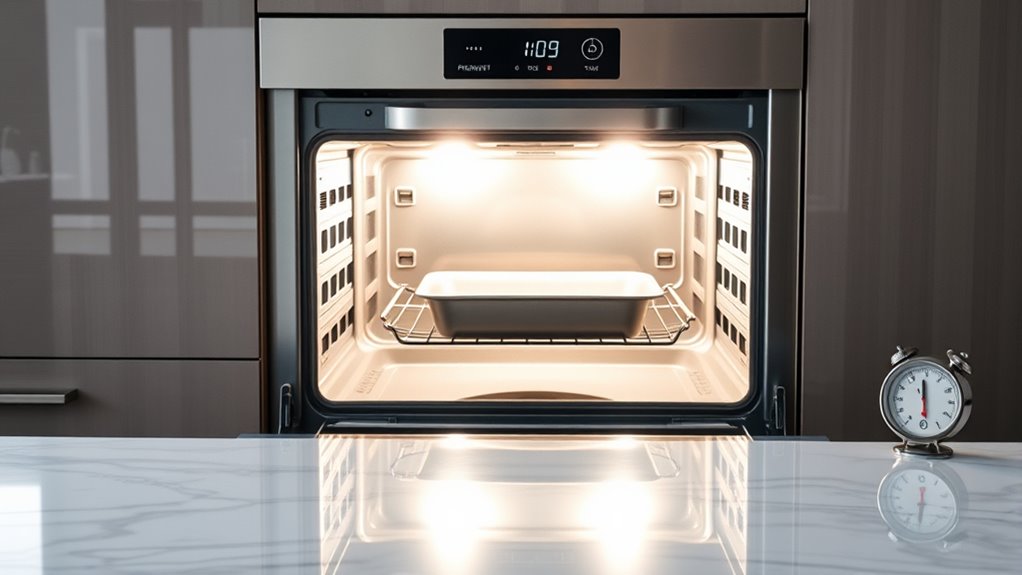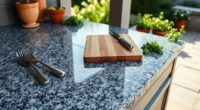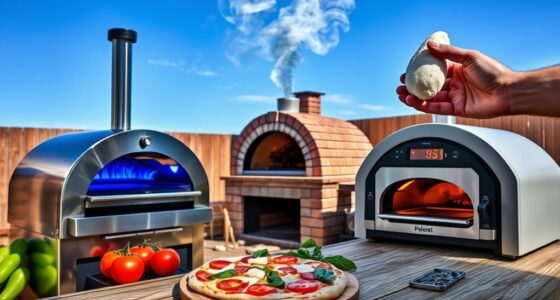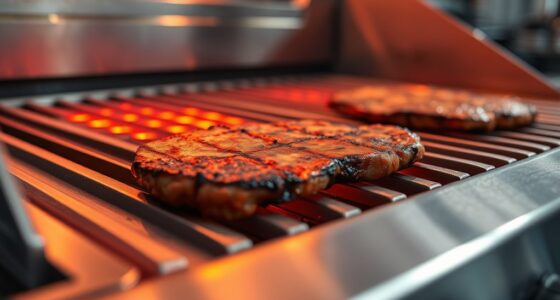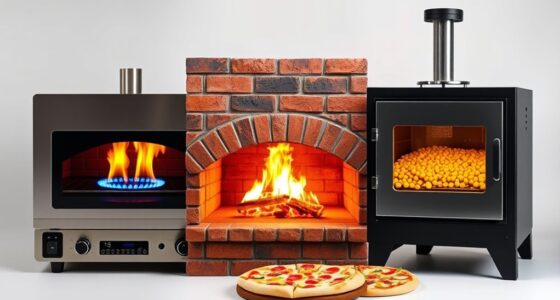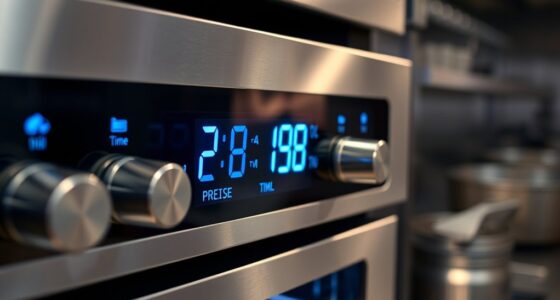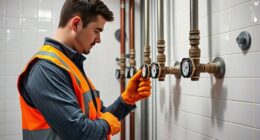Preheating your oven for about 10–15 minutes guarantees it heats evenly and your baked goods turn out just right. Look for steady glowing elements or indicator lights to know when it’s ready, and use an oven thermometer for accuracy. Avoid opening the door too soon or frequently, which can mess with the temperature. Keeping these tips in mind helps prevent common mistakes. Want practical tips to perfect your preheat timing? Keep exploring for all the essentials.
Key Takeaways
- Most ovens require 10–15 minutes to preheat to ensure even and accurate cooking.
- Use visual cues, indicator lights, or an oven thermometer to confirm when preheating is complete.
- Avoid opening the oven door early or frequently to maintain temperature stability.
- Adjust preheat time based on recipe type, oven age, and calibration for optimal results.
- Keep the oven door closed during preheating and turn off a few minutes early to save energy.
Why Preheating Matters

Preheating your oven is essential because it guarantees your food cooks evenly and correctly. When you skip this step, hot spots can cause uneven baking, affecting both texture and flavor. Proper preheating also promotes oven safety by reducing the risk of accidents caused by hot or malfunctioning appliances. Regular appliance maintenance, including keeping vents clean and checking the heating element, ensures your oven heats efficiently during preheating. This process allows the oven to reach the desired temperature securely and consistently, preventing undercooked or burnt food. Additionally, preheating helps maintain the oven’s longevity, reducing wear and tear caused by sudden temperature changes. Prioritizing oven safety and routine maintenance makes preheating an essential part of responsible and effective cooking. Being aware of oven temperature control is crucial for optimal baking results.
How Long to Preheat Your Oven
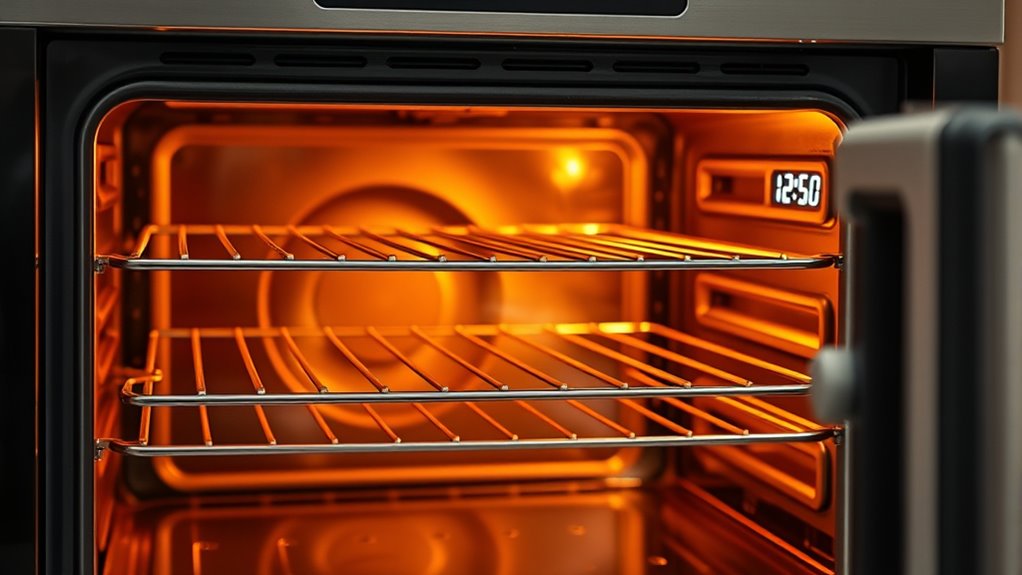
Knowing how long to preheat your oven guarantees your food cooks properly and saves time. Most ovens need about 10 to 15 minutes to reach the desired temperature, but this can vary based on the oven model and the temperature setting. Preheating for the right amount of time assures oven safety, preventing uneven heating or hot spots that could cause accidents. It also enhances cooking efficiency, so your dishes bake evenly and thoroughly. Rushing the process might lead to undercooked food or inconsistent results, while waiting too long wastes energy. To optimize your preheating time, consult your oven’s manual or look for visual cues like the display indicating it’s ready. Proper preheating is a simple step toward better cooking results and safer kitchen practices. Additionally, understanding your oven’s specific Fokos features can help improve preheating accuracy.
Recognizing When Your Oven Is Ready
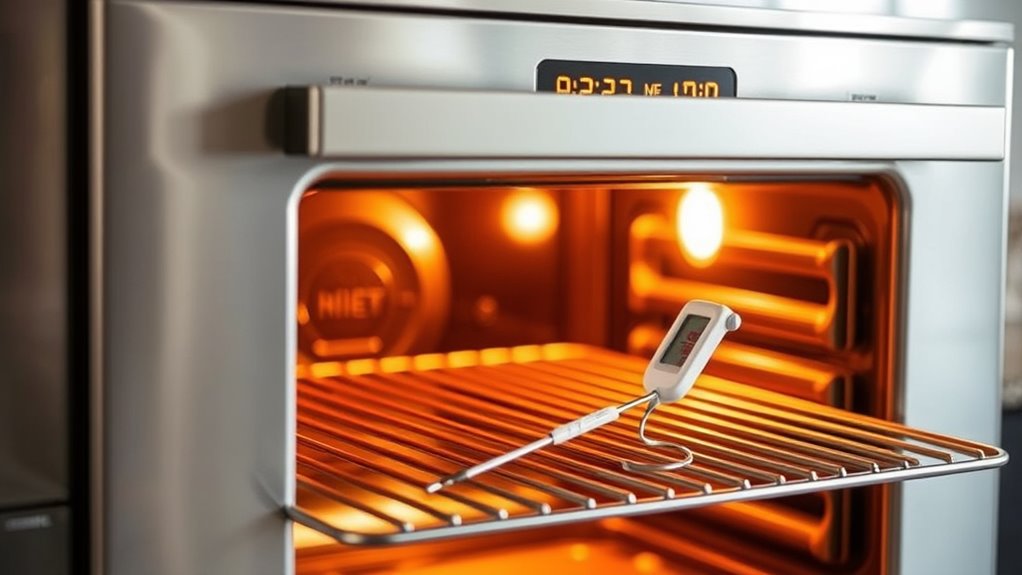
You’ll know your oven is ready when you notice visual cues like a steady glow or indicator light. Listening for a specific sound, such as a beep or chime, can also signal it’s preheated. Additionally, trusting your timer and temperature settings helps confirm that the oven has reached the right heat.
Visual Indicators of Heat
While many rely on the oven’s internal temperature dial, visual cues can provide a quick and reliable way to tell when your oven has reached the desired heat. Look for the glow of the heating elements, which often turn red or orange when hot enough. Some ovens have a light that turns off or on as the heating elements activate, serving as a useful temperature indicator. You might also notice a slight puff of steam or a steady warm air flow, signaling the oven is ready. Additionally, if your oven has a preheat indicator light, wait for it to signal completion. Relying on these visual cues helps you avoid guessing, ensuring your oven is at the right heat for perfect baking or roasting. Incorporating lifestyle strategies like setting a timer can also help you stay aware of the preheating progress.
Timer and Temperature Settings
Setting the correct timer and temperature on your oven is vital for guaranteeing it’s ready for baking or roasting. When you set the timer, it helps you track how long the oven has been preheating, preventing overuse and supporting energy efficiency. Accurate temperature settings ensure your oven reaches the desired heat level quickly, which is essential for oven safety and consistent results. Use your oven’s display or control panel to adjust the temperature precisely, avoiding unnecessary energy consumption. Once the oven hits the set temperature, most models will alert you with a beep or indicator light, signaling it’s ready. Confirming these settings helps prevent under- or over-preheating, ensuring safe operation and optimal cooking performance. Proper timer and temperature management keeps your oven efficient and safe to use. AI discoveries have shown that precise control can also improve overall appliance performance and longevity.
Oven Sound Cues
Oven sounds are reliable cues that your appliance has reached the desired temperature. When preheating, pay attention to the oven temperature hum—this steady, consistent noise usually indicates the oven has heated sufficiently. Many ovens emit a soft beep or chime once they hit the set temperature, but the oven sound cues like the hum are more subtle indicators. Once you hear the steady oven temperature hum or notice the beep, you can confidently start cooking. Listening for these sound cues can help prevent over- or under-preheating. Avoid opening the door too early, as it can cause temperature fluctuations. Recognizing these cues helps ensure your oven is properly preheated, leading to more consistent baking results. Trusting these sound cues saves time and prevents under- or over-heating your dishes.
Factors That Affect Preheat Time
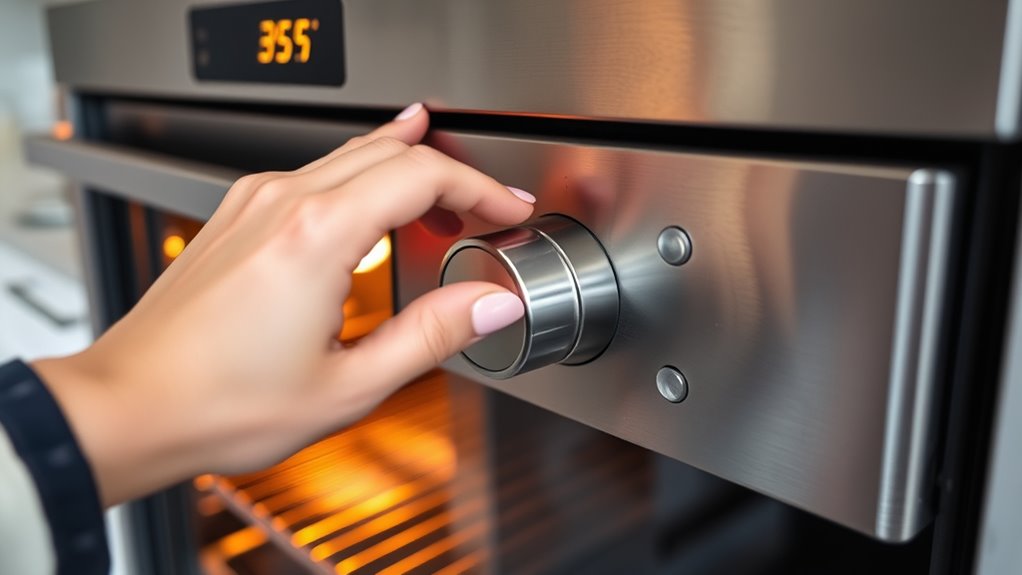
Several factors can influence how long it takes for your oven to reach the desired temperature. Ingredient variations, such as the moisture content or size of your ingredients, can impact preheat time because they affect how heat is transferred. For example, denser or larger items may require a slightly longer preheat period to ensure the oven reaches the set temperature evenly. Additionally, oven age plays a significant role; older ovens often have less efficient heating elements and may take longer to preheat compared to newer models. Other factors, like whether your oven has a convection feature or if the door is opened frequently during preheating, also affect timing. Being aware of these elements helps you better estimate when your oven is ready to bake. Oven efficiency can vary widely based on maintenance and model type, influencing preheat durations.
Preheating Tips for Different Recipes
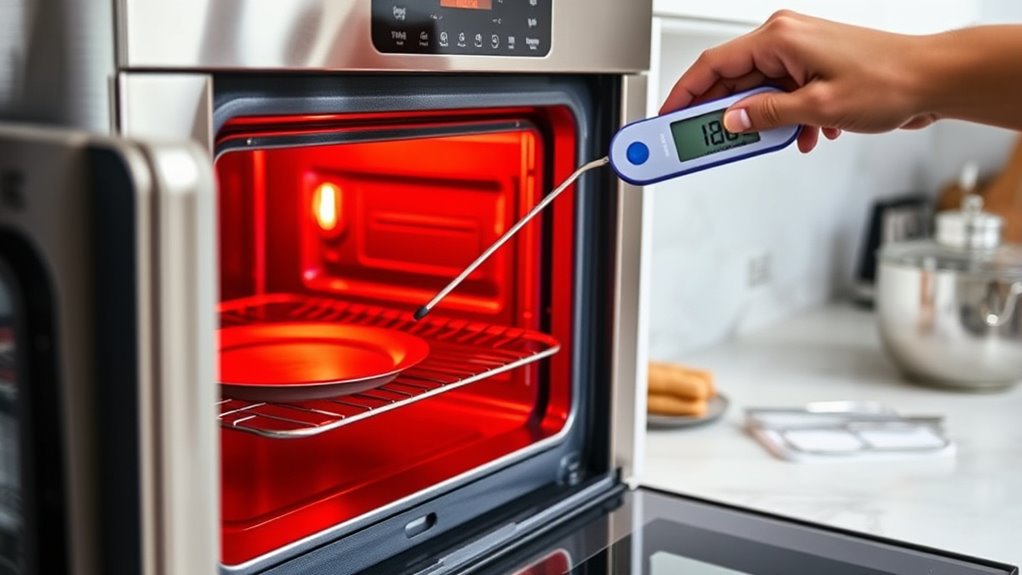
When preparing different recipes, you should adjust your preheat time based on the baking type. Some dishes, like bread or pizza, need a hotter oven, while others, like delicate cakes, require a gentler start. Keep in mind that time variations by recipe can impact your results, so tailor your preheating accordingly. Proper oven temperature control is essential for achieving consistent baking outcomes.
Adjust for Baking Type
Different types of baked goods require specific preheating adjustments to guarantee ideal results. For delicate items like soufflés or meringues, you need a stable, accurately calibrated oven to prevent uneven rises. Denser baked goods, such as bread or casseroles, benefit from higher preheat temperatures for thorough cooking. Use this table to visualize common baking types:
| Baking Type | Recommended Preheat Focus |
|---|---|
| Pastries & Cookies | Precise oven calibration for crispness |
| Bread & Casseroles | Slightly higher temp for even rise |
| Delicate items | Steady, accurate temperature for stability |
Adjust your preheat based on the recipe’s baking techniques, ensuring your oven’s calibration is spot-on for consistent results every time. Maintaining proper oven calibration is essential for achieving the best baking outcomes.
Time Variations by Recipe
Preheating times can vary considerably depending on the recipe you’re preparing. Baking science shows that delicate pastries, like soufflés or meringues, often need a fully preheated oven to rise properly, while casseroles tolerate a slightly lower start. Heavier recipes, such as bread or roasts, may require longer preheating to ensure even heat distribution. Your oven calibration also influences timing; an oven that’s out of calibration might need more time to reach the desired temperature. Always check your oven’s accuracy with an oven thermometer. Adjust preheat times based on the recipe’s sensitivity to temperature changes, and remember that different baked goods respond uniquely to heat. Tailoring your preheat guarantees your results are consistent and baked to perfection. Additionally, understanding your oven’s digital capabilities can help optimize preheating procedures for various recipes.
Common Mistakes to Avoid During Preheating

One common mistake during preheating is opening the oven door too soon or too often, which can cause the temperature to fluctuate and affect your cooking results. Over preheating can lead to uneven baking, while ignoring temperature buildup may result in undercooked dishes. To avoid these pitfalls, stay patient and let your oven reach the proper temp before placing food inside. Here’s what to watch out for:
| Mistake | Effect | Solution |
|---|---|---|
| Opening door early | Temperature drops, uneven cooking | Wait until preheat completes |
| Ignoring temperature | Under/overcooked food | Use an oven thermometer |
| Over preheating | Wasted energy, burnt food | Preheat only as needed |
| Rushing the process | Inconsistent results | Follow recommended times |
| Neglecting oven calibration | Inaccurate temperature readings, inconsistent results | Regularly calibrate your oven |
Using Oven Thermometers for Accuracy
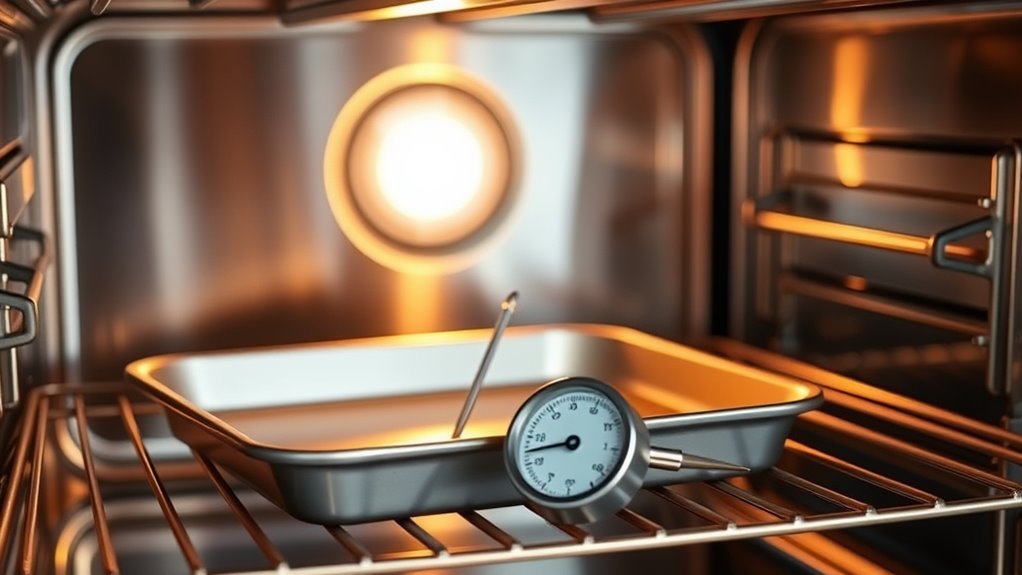
To guarantee your oven reaches and maintains the correct temperature, using an oven thermometer is essential. It provides reliable temperature accuracy, ensuring your baked goods turn out perfectly. Place the thermometer in the center of the oven for the most accurate reading. Regularly check the thermometer against your oven’s built-in gauge to identify discrepancies. This helps you adjust your preheat time or oven settings accordingly. Keep in mind:
- Oven temperature gauges can be inaccurate over time
- A quality oven thermometer offers precise readings
- Consistent use helps detect temperature fluctuations
- Proper placement enhances measurement accuracy
- Regular calibration maintains reliable results
Using an oven thermometer empowers you to fine-tune your oven’s performance, leading to better cooking outcomes and energy efficiency. It’s a simple step that ensures your oven’s temperature accuracy every time.
Saving Energy While Preheating

Using an oven thermometer helps you monitor the actual temperature, which is key to avoiding unnecessary energy waste. By accurately tracking the preheating duration, you prevent over-preheating and reduce energy consumption. Keep your oven at the right temperature for the shortest possible time before cooking begins. Avoid opening the door during preheating, as this causes heat loss and extends the process. Consider turning off the oven a few minutes early if it has reached the desired temperature—residual heat will finish the job. This practice promotes energy conservation and shortens preheating time without sacrificing cooking quality. Being mindful of your preheating duration ensures you’re using your oven efficiently, saving both energy and money in the long run.
Frequently Asked Questions
Does the Oven’s Age Affect Preheat Times?
Yes, your oven’s age can affect preheat times. As it gets older, oven calibration and heating element lifespan may decline, causing it to take longer to reach the desired temperature. You might notice inconsistent heat or longer preheat periods. Regular maintenance, including calibration and replacing worn heating elements, helps guarantee your oven heats efficiently and maintains accurate temperatures, making preheating quicker and more reliable.
Can Preheating Damage Oven Components?
Preheating your oven won’t cause damage if you follow proper oven safety. Think of it as warming up a car—if you overdo it or leave it running too long, components can wear out. Preheating helps ensure even heat distribution, preventing hot spots that could harm oven parts over time. Keep an eye on the recommended times, and your oven will serve you well, maintaining its performance without risking deterioration.
Is It Necessary to Preheat All Types of Ovens?
Not all ovens require preheating, depending on your cooking method. For baking bread or pastries, preheating is essential for even heat and proper rise. However, for roasting vegetables or slow-cooking dishes, you can often skip preheating without compromising safety or results. Always follow your oven’s instructions to guarantee oven safety and ideal cooking. Preheating helps maintain consistent temperatures, ensuring your food cooks evenly and safely.
How Does Altitude Impact Preheat Duration?
Altitude can dramatically increase your preheat duration, making it seem like your oven takes forever! You’ll need to do an altitude adjustment, as preheat variability becomes more pronounced at higher elevations. The thinner air cools the oven’s heating elements, so it takes longer to reach the right temperature. Expect to add extra minutes to your preheat time, especially above 3,000 feet, to make sure your oven’s hot enough for baking perfection.
Should I Open the Oven Door During Preheating?
You shouldn’t open the oven door during preheating because it can cause temperature fluctuations. Keeping the oven door closed helps maintain the preheat temperature, ensuring your oven reaches the desired heat evenly and quickly. Opening the door lets heat escape, making it take longer to reach the right temperature and potentially affecting your cooking results. So, resist the urge and wait until preheating is complete before putting your food in.
Conclusion
Now that you know the ins and outs of preheating, aren’t you ready to bake with confidence? Remember, a properly preheated oven guarantees your dishes turn out perfectly every time, saving you time and energy. Don’t let guesswork ruin your recipes—trust your oven’s readiness and follow these tips. Are you prepared to elevate your baking game and avoid common mistakes? Happy baking!
